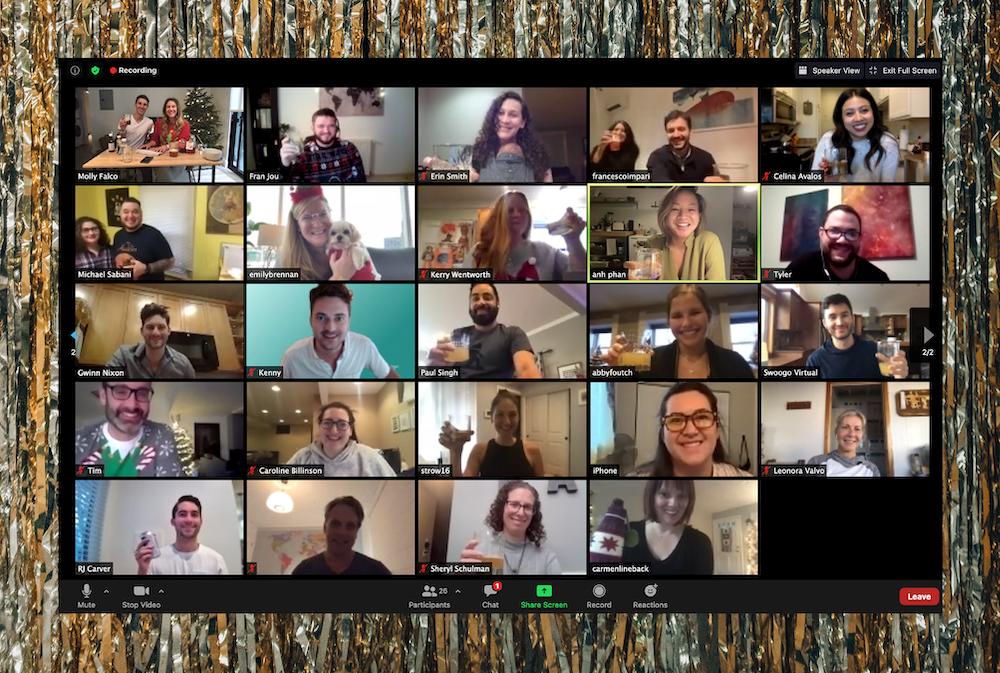It’s not news that most of the world is working remotely. There’s been an influx of information about how to be productive while working from home and best practices for working remotely, but we aren’t here to add to the noise. We are here to share what works from experience.
Swoogo started as a fully remote company five years ago and never looked back. We never had an office because we saw all of the cost-saving benefits along with the ease of building a global team. Being fully remote has helped define us and has led to employing individuals in four different continents. We wouldn’t change it, but we have learned and refined our ways.
Here are six lessons from a fully remote team.
1. Videos calls are a must
Since the beginning, we’ve held all of our meetings over video chat. This has made a world of difference in our company culture, focus, and accountability.
Company culture. When people join a fully remote company, there’s no walk through the office to meet people and have small talk. Having video calls is the “walk-through.” Video calls allow people to put faces to names, and you can get more of a feel for a person’s personality. All of this helps build company culture.
It’s the first 3-5 minutes of the call when you’re waiting for someone to hop on and you’re chatting about the weekend. It’s the small jokes or facial expressions you get to see. It’s the inside scoop to seeing how they are genuinely doing: are they visually stressed or calm and relaxed? Video calls help build and mould your relationships in a way that audio calls cannot.
Focus. When you’re on video, it’s pretty obvious when someone is multitasking, and that’s not a good look. Video calls ensure that you are focused on the meeting and not doing your dishes or checking your emails.
Accountability. Video calls are the closest thing to being in-person, and they truly hold you accountable. It’s your face and your word. It holds you to a level of accountability that you don’t get with audio calls. Instead, you are held accountable for being on the call and being present. Sometimes it even holds us accountable for getting out of bed, brushing our hair, or changing our shirt (no judgement).
The exception. All of our company calls start on video, and 99% of them are completed on video. However, there is one exception in which we’ll go off video, and that’s when an individual has bad wi-fi. Bad wi-fi can ruin the meeting for everyone involved. In this case, we may shut off our videos to help save that particular individual the bandwidth needed, and have a smooth audio call.
You may be thinking that working remotely requires a good wi-fi signal, and you’re right. However, as a fully remote team, we allow our employees to live anywhere they want. This has produced a few digital nomads within our organisation. They travel around the world while working and sometimes run into mediocre internet.

2. Have yearly or semi-annual offsites
Since we’ve never had an office, we place a lot of value on our semi-annual offsites. An offsite is a meeting that takes place out of the office. Or for a fully remote team, the meetings in which we actually get together in-person.
Since Swoogo is a global company, our offsites are 2-3 days long. You can imagine that employees flying from four different continents doesn’t pair well with a meeting that’s only a couple of hours long.
So, we fly the entire company to the location of the offsite, and we stay there for a few days. This gives us multiple days to work together in-person, meet new employees that we may not have met yet in-person, and create memories that we’ll laugh about on video chat for years to come.
Pre-COVID we had two offsites a year. One in the spring and one at the end of the year.
The spring offsite is typically combined with our annual user conference. Unconventional. This is the perfect way for a fully remote team to kill two birds with one stone. Instead of flying in employees to the location of our user conference, we have our offsite there a few days before. Not only does this allow for the typical benefits of having an offsite, but it also gives us time to finalise logistics and have all hands on deck for our event.
The end-of-year offsite is perfect for reflecting on our previous year of business, as well as goal setting for the upcoming year. Not to mention we get to have an in-person holiday party, an event that people may assume wouldn’t happen with fully remote companies.
When it comes to offsites, think outside of the box! If your company is primarily based in the UK, think about having an offsite abroad or having an offsite close to activities you may want to do as a team. Last year, Swoogo had its end-of-year offsite in Miami, Florida. We had a few days to reflect on our previous year and upcoming year, but we were also close in proximity to activities that we’d do as a team, such as Topgolf.
We excitedly throw out future offsite locations on team calls. Some people are hoping for an offsite in the mountains where we can go skiing or snowboarding and others are hoping the company will fly us to Australia. The options are endless!

3. Schedule one-on-one meetings
Group meetings have their time and place, but not everyone thrives during group calls. One-on-one meetings are where you can really connect with an individual personally and professionally. This is necessary for fully remote teams, where day-to-day communication may be limited.
During our one-on-one calls, directors are asking how you are doing personally and how things are going with work and the workload. Employees are more willing to open up and speak freely or ask questions that they might not have wanted to in front of a group (even if it was a small group).
Not only do we have one-on-one meetings with directors and people on our team, our CEO, Chris Sykes, schedules one-on-ones with every employee in the organisation.
Depending on your organisation size, it may be difficult to maintain the frequency of a monthly one-on-one. However, for Chris, it allows him to stay connected to the work that people are actually doing, stay close to our customers, get a feel for morale, and to get to know people on a personal level.

4. Prioritise company culture
Company culture is the shared values, goals, attitudes, and practices that define an organisation. We’ve mentioned company culture throughout the article because it’s truly the driving force for fully remote companies, and Swoogo’s culture, in particular, is something we take great pride in as a company.
Our culture is in everything we do, from the language we use to our offsites. The definition above is a pretty high-level definition of company culture. Still, it’s even the smallest things that make a difference, from the jokes we crack on video calls to the emojis we post on messenger.
Being a fully remote company allows us to hire the best person for the job, period. The world has a lot of talented people, so yes, this opens doors. However, for us, it’s not about hiring the absolute best person at their job. It’s hiring the best person at the job that fits into our company culture. This is an important distinction.
Someone could be the absolute best at their job, hands down, but if they don’t fit in with the company culture, they aren’t going to thrive in the organisation. At Swoogo, we’re a hard-working, fun-loving, quirky bunch. We wear our t-shirts and jeans and get our job done while having fun. If someone is looking for a suit and tie organisation that wants the vibe to be strictly business, then they most likely aren’t going to fit in with our company. And that’s ok! You can’t win them all.
So bottom line, hiring globally allows us to find the best person at the job that fits into our company culture.
5. Being social
Being fully remote does require extra efforts to stay social “around the office,” but we’re here to tell you it can be done! Here are some fun ways Swoogo stays social:
Company-wide social huddle. Every week we have a company-wide huddle, and once a month, it’s a social huddle. So we throw out a discussion topic, and everyone has to answer it. Once you’ve answered, you call on someone to go next.
Sure some topics fall flat, but for the most part, our social huddles are full of laughter and a busy comment box. This allows people across the organisation to get to know each other. We might not know all the details about everyones’ home life, but we know their biggest pet peeves and favourite bands.
Non-work-related message boards. When you go into an office, there’s small talk walking in, there’s stopping by your favourite co-worker’s desk, and even coffee chats. Although these exact moments can’t happen with fully remote teams, we can mimic them in different ways.
One of which is having non-work-related message boards. This is where you share pictures of your favourite fur animals and post about that random Buzzfeed article that made you laugh. In our non-work-related message board, we have people sharing memes, holiday wishes, and random thoughts. It’s a nice break from always checking messages related to work.
Update your status. If your messaging software allows you to update your status, this can be a fun way to see what your co-workers are up to. At Swoogo, some people have emojis by their name that shows when they are in a meeting, eating pizza for lunch, or taking some time to concentrate and get a task completed.
Update your profile. Depending on the size of your organisation, you most likely don’t know every single person and what they do. If your messaging software allows, it’s really helpful to keep your profile up-to-date with your job title and maybe even a layman’s description. This way, when Joe comments on the picture of your dog, you can see who Joe is and what his role is with the company.
Get creative. There are so many more ways that you can get social within your organisation. The items above are the day-to-day ways that Swoogo connects as a company, but there are so many more ways that we have connected over the years.
For example, during the holidays this year, we had a virtual bartending course where we were shipped the supplies to make three different cocktails led by a mixologist. We’ve also had book clubs where people from different parts of the organisation were able to connect in small groups.

6. Overlapping hours are critical
It’s so important to be able to connect with your team when you’re fully remote. This doesn’t mean that you have to be online the exact same hours that they are, but it’s crucial that there are a few overlapping hours. Especially if there are multiple people living in different timezones.
Overlapping hours allow for questions and collaboration to take place during the workday, which overall increases the efficiency of the business.
Wrap up
We’re so proud of the fully remote team we’ve built at Swoogo. Being fully remote has its challenges, but overall we think it’s a great opportunity that a lot of companies will be taking advantage of after having forced exposure to it.
To be a part of a remote team is taking the extra step to make an effort. This falls on both the company and the employee, but ultimately it’s a win-win for everyone.
Originally published Mar 17, 2021, updated Jan 13, 2023
